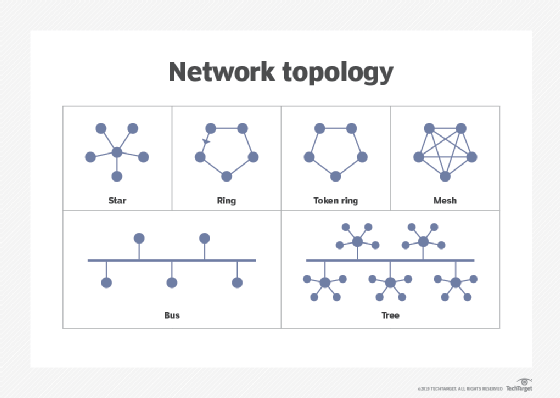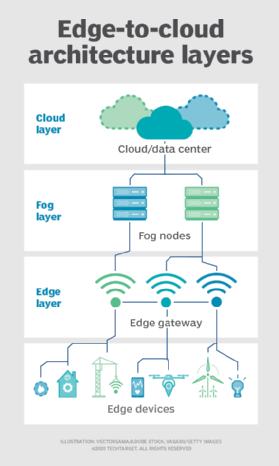What is a network node?
A network node is a connection point in a communications network. This point, often known as an endpoint, is attached to the network and can send and receive data over that network. It can also create and redistribute data along various network routes. Examples of endpoints or end nodes include computers, smartphones and printers.
Not all nodes are endpoints, however. Some nodes are intermediate nodes that don't create or terminate data but rather direct it to the appropriate destination. Examples include routers and switches. Similarly, there are centralized nodes known as servers that store data and provide resources to other nodes in the network.
What is a computer network, and where do network nodes fit?
A computer network is a system of computers and computing devices connected via communication links. These links allow computers and other devices to send information over the network and share it among multiple digital devices, known as nodes.
Within a network, each node is often an endpoint for data transmissions or redistribution. Nodes have either a programmed or engineered capability to recognize, process and forward transmissions to other network nodes.
The concept of network nodes originated with the use of distributed networks and packet switching. Depending on the application, network nodes perform a variety of functions. Computer networks and the nodes connected to them make things like video streaming, social networks and cloud networks possible.
Computer networks can be physical or logical. A physical computer network is a "real" network comprised of cables and devices that send data back and forth. In contrast, logical networks are software representations of a physical network and are built on top of a physical network.
Regardless of the type, networks are governed by network protocols. These are the widely accepted and standardized rules defining how information is sent and received over a network. Networks can be defined by the protocols they use. They can also be defined by their geographic location, and the physical arrangement of the network components and their purpose.
The internet is an example of a computer network. It is made up of many smaller computer networks, each comprised of hundreds of thousands of nodes.
Examples of nodes in networking
Nodes are the building blocks of any network because they enable the flow of data, which then makes network communication possible. The data flows can be simple, such as file transfers between two laptops, or complex, such as between two servers in a data center.
In modern networks, the term "node" encompasses a wide variety of connecting entities. Examples of network nodes include the following:
- Computers (PCs and laptops).
- Smartphones and other network-connected mobile devices.
- Servers.
- Routers.
- Switches.
- Printers.
- Sensors
- IoT devices.
Network bridges that connect multiple LANs to form larger networks are also considered nodes.
What does a network node do?
A network node sits at a point in the network where it sends, receives, stores or creates information. It transmits data to communicate with other nodes in the network. Different nodes connect over a link or communication channel to form a network. These connections can be cable, fiber optic or wireless.
In a computer network, nodes can be physical networked devices, such as modems, PCs and printers. These devices recognize transmissions from other nodes and forward them to other nodes. Nodes like PCs and laptops can also share resource nodes like printers and files. Some nodes, like routers, can also forward data to ensure it reaches the appropriate destination.
The nodes connected to a network each have a unique IP address. It acts as an identifier that differentiates one node from another and helps with their discovery. Node discovery is often achieved with the help of automated tools that scan the network and create a visual display to show the various interconnections. Doing so can help with network troubleshooting and performance optimization. It can also help to identify unauthorized or potentially malicious devices connected to the network. The IP address is also needed to enable the node to access network resources and communicate with other nodes.
Modern nodes go way beyond simply facilitating data transfers. Depending on the application and network setup, nodes can also integrate cutting-edge technologies like cloud computing, edge computing and AI to perform more complex tasks like automations, data analysis and real-time data processing. Many nodes also incorporate security features like firewalls, data encryption and user authentication to protect data, prevent unauthorized access to the network, and reduce the probability of cyberattacks.
What are the types of network nodes?
There are several ways to categorize nodes. One is by network type, and another is by network topology.
Nodes by network type
- Data communications. Data communications nodes are physical network nodes like data communications equipment or devices that sit between data terminal equipment (DTE) and data transmission circuits. These include switches, bridges, modems or hubs that perform signal conversion, coding and line clocking. These nodes also include DTE, such as digital telephone handsets, printers, routers, servers and workstations.
- Internet network. On the internet and with intranets, most physical network nodes are host computers identified by an IP address. However, some data link devices, such as wireless LAN (WLAN) access points, do not have IP host addresses. They are considered physical network or LAN nodes rather than internet nodes or hosts.
- LAN and wide area network (WAN). These nodes are devices that perform a specific function, such as printing, resource-sharing or troubleshooting network issues. Each LAN or WAN node must have a media access control address (MAC address) for each network interface card (NIC). Examples include modems with Ethernet interfaces, WLAN access points and computers.
- Telecommunications network. In fixed telephone networks, nodes can be public or private telephone exchanges or computers that provide intelligent network services, such as data transfers or redistribution. In cellular communications, nodes include base station controllers that control one or more base stations.
- Cable system. In cable systems, nodes use fiber optic cable to connect to businesses and homes served by a common fiber optic receiver within a geographic location. A fiber optic node describes the number of homes or businesses a specific fiber node can serve.
Nodes by network topologies
Another way to categorize nodes is by how they are arranged in a physical computer network. This is known as the network topology approach. Some common network topologies include the following:
- Bus topology connects individual nodes directly to a main cable. A common example is cable broadband distribution networks.
- Ring topology has nodes connected in a loop or ring; each node has a neighbor on each side and the data can pass either in one direction or in both directions. Metro networks usually connect their nodes using a ring topology.
- Star topology connects all nodes to a central hub. Most wired home and office networks connect their nodes (PCs, printers, scanners, etc.) with a star topology.
- Mesh topology has every node connected to every other node, creating multiple paths between various nodes in the network.
In addition to the above, network nodes can be connected using a hybrid topology. Such networks combine two or more topologies (ring and mesh, star and bus, etc.) to provide greater connection flexibility and scalability.

What are examples and applications of network nodes?
Examples of how network nodes are used include the following:
Print request. An employee sends a print request from a computer to a printer in another office. The employee's computer is a node on the network. The request travels over the network and through a series of other nodes -- a router, for example -- on the company LAN. The request reaches the printer, also a node; it processes the request and completes the printing job.
Base station controller. This is a node on a cellular network that provides intelligent network services to devices. The base station controller sits between the cell sites and the mobile switching center, which are also nodes on the cell network. Base station controllers determine how cell signals should be routed through the network.

Peer-to-peer mesh network. A peer-to-peer mesh network lets mobile devices communicate information without Wi-Fi or cellular service. In a mesh network topology, every node connects to every other node. Cellphones act as nodes and extend their signals to other cellphones in the network that might be experiencing a service outage. IBM's The Weather Company uses this approach to transmit critical information when other networks are down.
Internet of things. IoT networks connect devices of all types -- not just computers -- to the internet. Each device is a node on the IoT network. Edge nodes create data from IoT devices. Fog nodes add another layer of physical servers, bringing real-time analytical processing to IoT networks.
Networks vary in size, connectivity, coverage and design. This guide examines the most common types of networks, along with their advantages and applications. Also, further explore the different types of network topologies.






